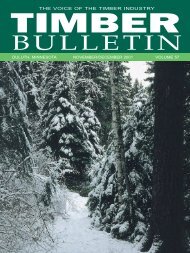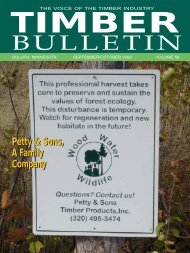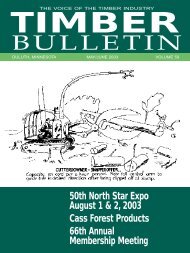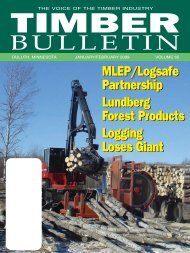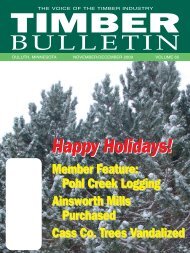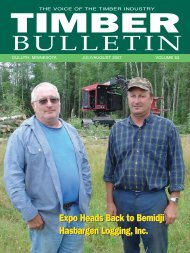Timber Bulletin Nov/Dec - Minnesota Forest Industries
Timber Bulletin Nov/Dec - Minnesota Forest Industries
Timber Bulletin Nov/Dec - Minnesota Forest Industries
You also want an ePaper? Increase the reach of your titles
YUMPU automatically turns print PDFs into web optimized ePapers that Google loves.
(continued from page 10)<br />
have been developed and are being<br />
implemented and monitored for<br />
compliance and effectiveness. The<br />
landscape level program is being<br />
developed and implemented to<br />
address broader landscape interests<br />
and concerns. The SFRA is based<br />
upon collaborative approaches and<br />
solutions. It is dependant upon<br />
diverse interests working together<br />
for sustainable solutions<br />
ecologically, socially and<br />
economically. While this approach<br />
seems slow and messy at times, my<br />
experience nationally, and<br />
particularly internationally, leads<br />
me to conclude it is the only way to<br />
achieve sustainability.<br />
Members of the DNR team in<br />
general, and particularly the<br />
forestry team, are committed,<br />
creative, innovative, efficient, and<br />
effective. We have been doing<br />
more with less for the past decade.<br />
The forestry team is stretched to the<br />
limit. New, creative, high energy<br />
leadership is needed to move MN<br />
forestry forward. Our forests are a<br />
crucial part of our functioning<br />
ecosystem, our social fabric and our<br />
economy. A strong Division of<br />
<strong>Forest</strong>ry is crucial to sustainability.<br />
I wish DNR leadership much<br />
success in the recruitment and<br />
appointment of new forestry<br />
leadership. Likewise, I wish<br />
success to the dedicated employees<br />
of the Division of <strong>Forest</strong>ry. This<br />
success is crucial to the quality of<br />
life of the people of <strong>Minnesota</strong> and<br />
to the sustainability of <strong>Minnesota</strong>’s<br />
natural resources.<br />
–Jerry Rose<br />
<strong>Forest</strong>ry Division<br />
Director Plans to Leave<br />
DNR January 26<br />
Gerald Rose, director of the<br />
<strong>Forest</strong>ry Division for the <strong>Minnesota</strong><br />
Department of Natural Resources<br />
(DNR), will be leaving that position<br />
January 26 after nearly 14 years and<br />
plans to join the staff of the<br />
National Association of State<br />
<strong>Forest</strong>ers.<br />
“I wish success to the dedicated<br />
employees of the DNR <strong>Forest</strong>ry<br />
Division,” Rose said. “This success<br />
is crucial to the quality of life of<br />
<strong>Minnesota</strong>ns and to the<br />
sustainability of <strong>Minnesota</strong>’s<br />
natural resources.”<br />
Rose said his tenure has been a<br />
period of high interest and conflict<br />
around forestry issues. Under<br />
Rose's leadership, the DNR<br />
<strong>Forest</strong>ry Division embarked on<br />
several innovative initiatives. The<br />
Environmental Quality Board<br />
completed the nation’s only state<br />
<strong>Forest</strong>ry Generic Environmental<br />
Impact Statement (GEIS), which<br />
evaluated the impacts of increased<br />
timber harvesting on the forest<br />
environment. <strong>Minnesota</strong>’s<br />
Sustainable <strong>Forest</strong>ry Resources Act<br />
of 1995, based upon GEIS<br />
recommendations, has led to<br />
collaborative approaches to<br />
managing <strong>Minnesota</strong>'s forestry<br />
resources. It is dependent on<br />
diverse interests working together<br />
to reach sustainable forestry<br />
management solutions that are<br />
ecologically, socially and<br />
economically sound. Rose said this<br />
innovative approach is the way to<br />
go.<br />
“While this approach seems slow<br />
and messy at times,” Rose said,<br />
“my experience nationally, and<br />
particularly internationally, leads<br />
me to conclude that it is the only<br />
way to achieve sustainability.”<br />
Brad Moore, DNR assistant<br />
commissioner for operations, noted<br />
Rose's important work on forestry<br />
management. “Jerry has done a<br />
fine job for us during his tenure,<br />
especially regarding sustainable<br />
forestry practices,” Moore said.<br />
“He will be an important asset at<br />
the national level.”<br />
Rose’s new duties with the<br />
National Association of State<br />
<strong>Forest</strong>ers (NASF) would include cochairing<br />
the National Roundtable<br />
on Sustainable <strong>Forest</strong>s, serving as<br />
NASF liaison to organizations with<br />
forest certification systems and<br />
other sustainable forestry<br />
initiatives, working with states on<br />
their sustainable forestry efforts,<br />
and representing the NASF on<br />
international initiatives dealing<br />
with sustainable forestry.<br />
“I wish DNR leadership much<br />
success in the recruitment and<br />
appointment of new <strong>Forest</strong>ry<br />
Division leadership,” Rose said.<br />
“Members of the DNR team in<br />
general, and particularly the<br />
<strong>Forest</strong>ry Division team, are<br />
committed, creative, innovative,<br />
efficient and effective.”<br />
Robert Tomlinson, currently the<br />
assistant director of DNR <strong>Forest</strong>ry,<br />
will serve as acting director while<br />
the DNR conducts a national search<br />
for a new director.<br />
The Wildfires and<br />
CO2 Emissions<br />
The tragic wildfires that burned<br />
uncontrollably around the country<br />
this summer had devastating<br />
impacts on the landscape. The<br />
wildfires destroyed over seven<br />
million acres of forest and<br />
rangeland habitat, engulfed wildlife<br />
in the flames, and denuded<br />
landscapes of vegetation. Less<br />
obvious was the significant<br />
contribution of greenhouse gases<br />
into the atmosphere.<br />
The burning of standing timber<br />
released significant amounts of<br />
carbon dioxide – as much a 25<br />
million metric tons, based on<br />
average timber volumes and wood<br />
densities per acre. This represents<br />
approximately eight percent of<br />
carbon sequestration on managed<br />
forestlands in the United States. As<br />
a percentage of total U.S.<br />
greenhouse gas emissions, it<br />
represents approximately one and a<br />
half percent.<br />
Under the Kyoto Protocol, the<br />
United States is committed to<br />
reducing greenhouse gas emissions<br />
seven percent below 1990 levels by<br />
2010. To accomplish this, the<br />
United States would need to reduce<br />
emissions by more than 600 million<br />
metric tons annually. Given that<br />
forests are a scientifically credible<br />
mechanism to reduce emissions<br />
and store carbon, forestland<br />
management can help achieve our<br />
domestic and international<br />
emissions targets. Clearly, the U.S.<br />
must use proper forest<br />
management to enhance the<br />
sustainability of the land base and<br />
prevent uncontrolled forest fires. By<br />
utilizing a long-lived carbon<br />
product, we can take advantage of<br />
our natural resource base in<br />
addressing the greenhouse gas<br />
emissions issue. For more<br />
information, contact Mitch<br />
Dubensky at 202-463-2434,<br />
mitch dubensky@afandpa.org.<br />
12 <strong>Timber</strong> <strong>Bulletin</strong> <strong>Nov</strong>ember/<strong>Dec</strong>ember 2000




